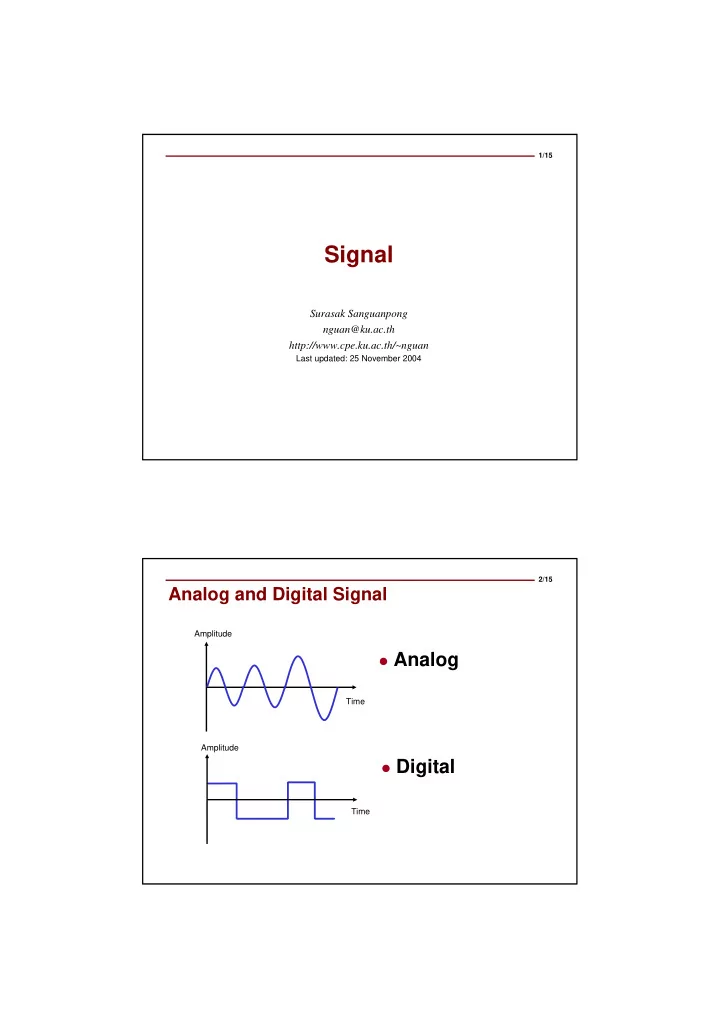

1/15 Signal Surasak Sanguanpong nguan@ku.ac.th http://www.cpe.ku.ac.th/~nguan Last updated: 25 November 2004 2/15 Analog and Digital Signal Amplitude � Analog Time Amplitude � Digital Time
3/15 Time Domain Continuous signal Amplitude Th signal intensity varies in a smooth fashion over time. lim s ( t ) = s ( a ) for all a Time t a Discrete signal Amplitude The signal intensity maintains a constant level for some period of time and then changes to another Time constant level. 4/15 Periodic and Aperiodic signals Periodic signals Aperiodic signals Amplitude Amplitude Analog Analog Time Time T T T T Digital Amplitude Digital Amplitude Time Time T T T T
5/15 Signal components Amplitude Amplitude at time t n 1 second 1 second Max Amplitude Beginning phase φ = 0 degree t n Time Min Amplitude Period T = 1/3 s T=1/f 3 periods in one second f = 3 Hertz Amplitude : strength of the signal � Frequency : rate at which the signal repeats (in Hertz[Hz]) � Phase : position of the signal relative to time zero � 6/15 Phase different s ( t ) = sin (2 π ft ) s ( t ) = sin (2 π ft+ π/2 ) 0 degree 90 degree s ( t ) = sin (2 π ft+3 π/2 ) s ( t ) = sin (2 π ft+ π ) 270 degree 180 degree
7/15 Changes in Amplitude and Frequency Amplitude change Frequency change 8/15 Phase Changes No phase change 90 degree phase change 180 degree phase change 270 degree phase change
9/15 Time and Frequency Domain Frequency Domain Time Domain Amplitude Amplitude 1 second 10 10 0 4 Frequency Time -10 frequency f = 4 Hz Amplitude Amplitude 1 second 10 10 0 Time 4 8 Frequency -10 frequency f = 8 Hz 10/15 DC Component Time Domain Frequency Domain Amplitude 1 second Amplitude 10 10 0 0 Time Frequency frequency f = 0 Hz Amplitude 1 second Amplitude 15 10 10 5 0 0 8 Time Frequency frequency f = 8 Hz
11/15 Frequency Components s 1 ( t ) = sin (2 π ft ) f ω s 2 ( t ) = 1/3sin (2 π ( 3 f ) t ) 3f s 3 ( t ) = sin (2 π ft ) +1/3sin (2 π ( 3 f ) t ) 3f f 12/15 Harmonics Any periodic waveform can be mathematically expressed as � ฅ s ( t ) = a 0 + Σ [ a n cos ( n2 π t/T )]+ b n sin ( n2 π t/T )] n=1 1 and 3 harmonics 1,3 and 5 harmonics 1,3,5 and 7 harmonics infinite number of harmonics
13/15 Bandwidth Bandwidth is the width of � the frequency spectrum 1000 6000 B=f h -f l Bandwidth = 6000-1000 = 5000 Hz f h = the highest frequency f l = the lowest frequency 100 200 300 400 500 600 700 800 Bandwidth = 800-100 = 700 Hz 14/15 Bit rate Bit rate = 8 bps Amplitude 1 second 1 0 1 0 1 1 0 1 Time Bit duration = 1/8 s bit interval = time to sent one bit bit rate = number of bits in one second
15/15 Bit rate and Frequency Transmission medium has a � Signal before limited bandwidth transmission with Digital signal has infinite bit rate: 2 Kbps � bandwidth Signal after transmission Selection of transmission � with various bandwidth medium relies on the cost of investment and the quality of Bandwidth: 500 Hz transmitted signal. Bandwidth: 2.5 KHz Bandwidth: 4 KHz
Recommend
More recommend